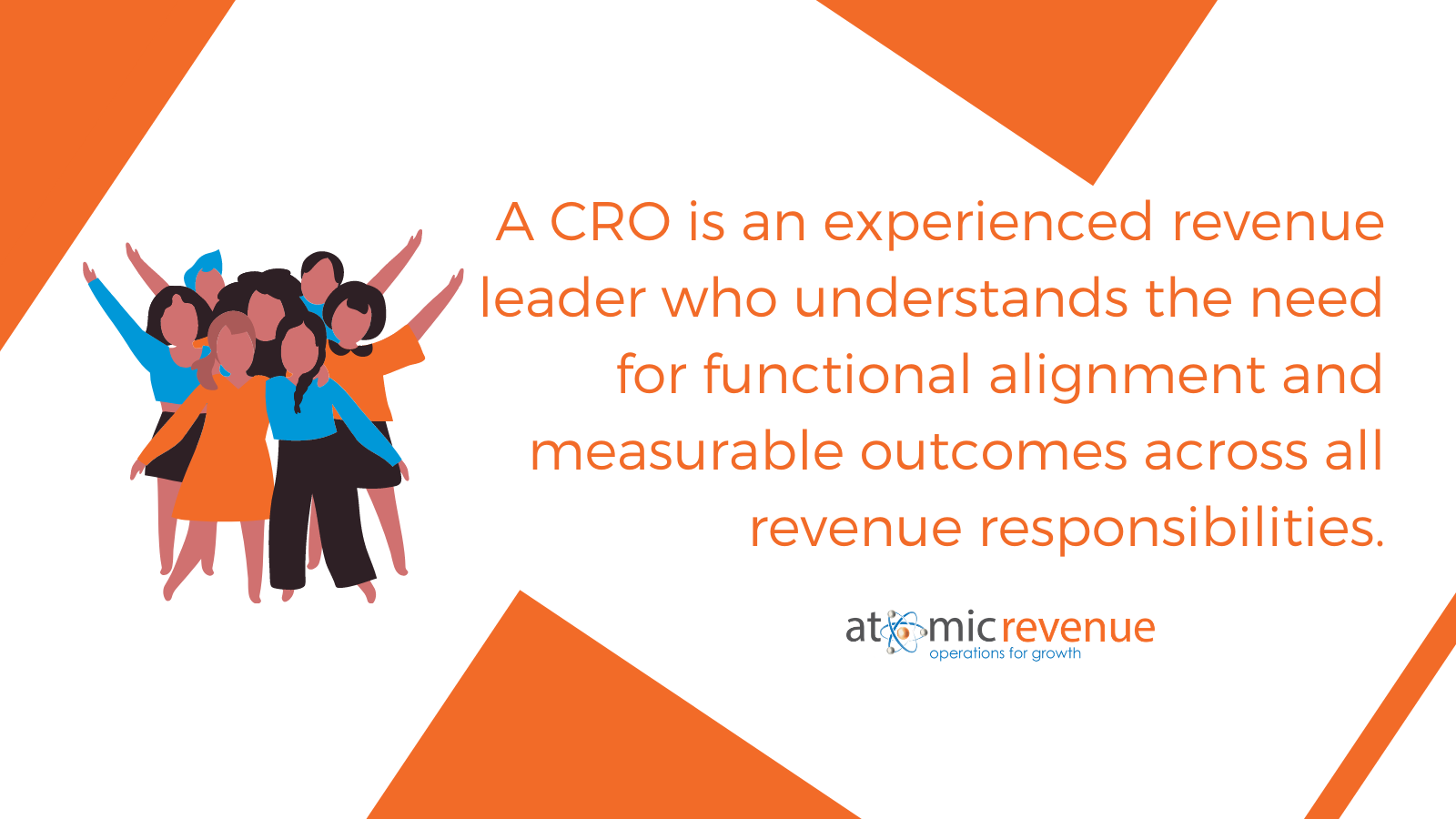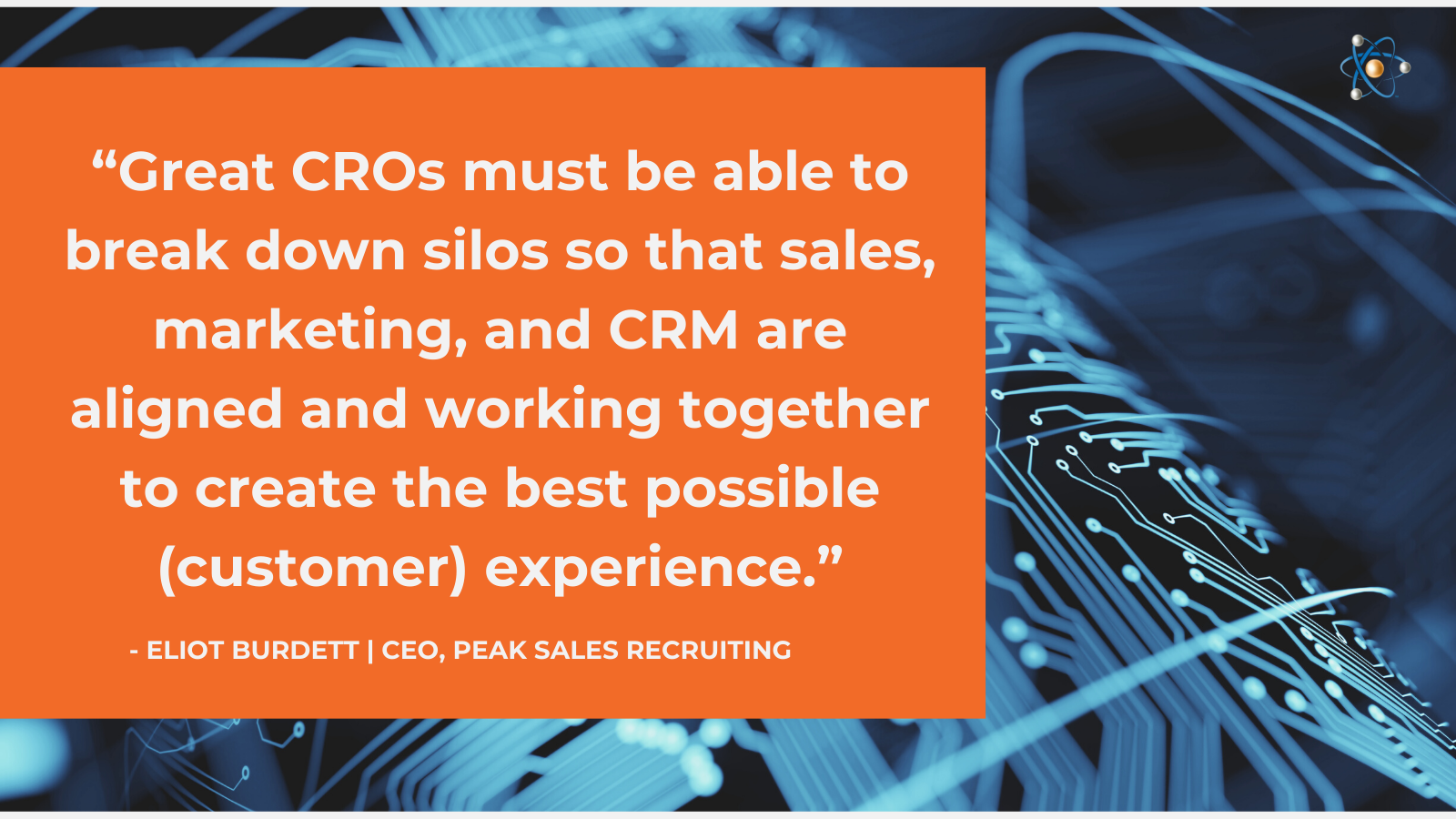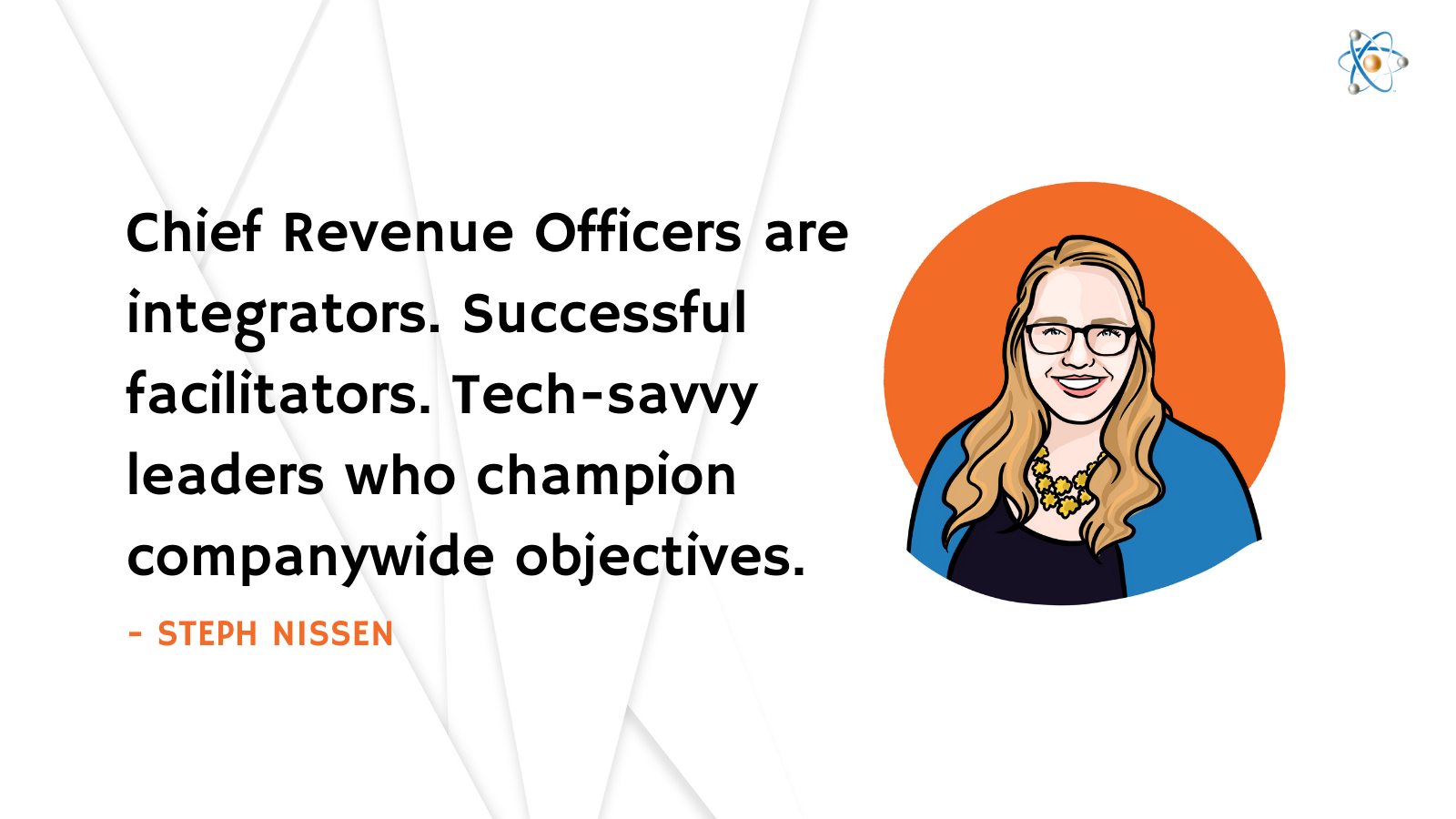
An effective Chief Revenue Officer is an integrator. A successful facilitator. A tech-savvy leader who is the champion of companywide objectives across all departments. Ultimately, a CRO knows when, where, and how to ensure anything and everything that affects revenue outcomes – all people, process, and data – is on track.
If this sounds like an incredible amount of responsibility, it is. That’s why it’s important to empower a strong CRO who is capable of being your organization’s master integrator. If you don’t already have a CRO, hiring the right person or promoting from within may be the most critical revenue-optimizing decision your company can make.
What Does CRO Mean?
The role of Chief Revenue Officer is fairly new. It began in Silicon Valley around 2010 to capitalize on new revenue opportunities created by digital products and services. Eliot Burdett, CEO of Peak Sales Recruiting explains, “A Harvard Business Review study of 95 teams from 25 leading corporations found that 75% of cross-functional teams are dysfunctional. That’s why, aside from being a sales and marketing genius, your CRO must be a tech-savvy business leader and diplomat who knows how to navigate the boardroom effortlessly.” We agree.
CRO Responsibilities Include:
- Must understand your processes across all departments
- Know how to work with all your people – in and out of the boardroom – from the warehouse and shipping to sales and marketing, from internal customer service teams and finance to HR.
- Must collect the right data to ensure the dashboard and KPIs, by which the company plans and grows, are measuring meaningful outcomes and that every department is working toward the same goal: customer advocacy.
This doesn’t mean the CRO does everything.
The objective of a CRO who is skilled in the art of getting all departments to work toward the same goals, is to create a scalable revenue system which sustains predictable and profitable revenue streams for the organization.
With a CRO on your team, revenue functions are no longer compartmentalized by a single department or task. Gone are the silos. Now, marketing, sales, and customer success teams ALL play a role in the production of revenue with accountability for structure, support systems, resources, and profitability.

What Does a CRO Actually DO?
A strong CRO integrates in a way that can be measured. A CRO does not give orders to department managers, dictate how people do their jobs or skirt accountability for revenue performance in a boardroom. He or she is accountable to the executive team and company ownership for integrating all revenue driving departments. The CRO communicates with department leaders and external partners, using metrics to find profitable revenue wherever it is within the company.
It’s not about one person taking control, it’s about collaboration. A CRO is your hub to the spokes. When one spoke doesn’t work quite right, the rest of the wheel turns, but inefficiently. An informed CRO will help manage solutions to fix problems before they effect revenue outcomes.
The bulk of the CROs role is tied to KPIs, knowing who’s responsible for them, where the data is coming from, and what lever needs to be pulled to affect the numbers in a desirable way.
For example, there may be a trend in KPIs that reflects rising shipping costs, but the root issue may not be the shipping department at all. It could be in product development, packaging design, logistical operations, or maybe your newest customers are overseas which increased shipping costs. Where’s the lever that needs pulling to turn the problem into an opportunity?
The CRO will get to the core of an issue and solve it with the leadership team. He or she will also champion what works well and help departments stay efficient. The CRO checks-and-balances costs, revenue, and profitability.
A CRO also creates a unified vision across departments and with vendors to develop an integrated customer-focused strategy with a corresponding plan to meet revenue objectives while achieving desired customer experience.

Empowering a Strong CRO: What is Needed for Success?
Your CRO must have the right data and information to keep all departments working toward the goal of customer advocacy. To empower a strong CRO's ability to get to the heart of profitability with the utmost success for your company, here is what is required:
Accurate, Up-to-Date Company-Wide Data
Organizational measurements and KPIs that allow the CRO to discover how to affect revenue outcomes in any and every department as-needed.
Permission, Authority, and Know-How
CROs must make quick decisions using the data. If the CRO does not have the authority to make decisions or change, they will not be trusted by department managers to facilitate the collaboration required to quickly remedy profit impacting issues.
Clean Information/Data Dissemination
This is crucial for decision making. All information, including all KPI reporting, should provide relevant and measurable data that is both controllable by the organization and actionable to advance desired outcomes.
Defined Customer Journey Map
This will outline all stages of customer engagement, mapped directly to the customer's buying journey, tied to each department’s responsibilities to bring desired outcomes to fruition.
Strong Software Tools
A strong suite of software and tools that provide a full platform for marketing, sales, service, and CRM that allow team members to share information, insights, and process collaboratively.
Tools and Technology
This will empower data-driven predictive insight that provide detailed information on how the customer buys and how changes to your selling process affect how the customer buys. This level of prediction is imperative to keep moving forward.
Company Commitment to Hire the Right Talent
In order to have a strong team, you need support from the CRO, for the right roles across all departments. Effective and bright leaders and employees who inspire departmental collaboration versus the historical guarding of turf.
To be most effective, in addition to managing and monitoring the CRM and KPIs, a CRO should be involved in strategy, and the people and process of that strategy – not just the technology that makes it happen.
A few examples: The Director of Marketing will work with the CRO on strategies that the CRO will integrate with the sales and customer service departments. The CRO will work directly with the CFO to combine and cross reference data insights that drive budgets, pricing, and competitive positioning. The CRO will integrate the vision of the CEO (and sometimes be the data-backed voice of reason to ward off shiny objects). The CRO will make sure that the CRM and all other systems used by all the departments reflect the strategy and measure associated impacts, thereby keeping an eye on whether systems and tools are being used correctly.
An empowered CRO will do all of these things and more, with the ultimate goal of customer advocacy that balances costs with revenue to get to the heart of profitability.

The EOS Model of “The Integrator”
Atomic Revenue runs on EOS®. We’ve adopted and adapted this business model to fortify our organizational structure. Our CEO, Tara Kinney, is “The Visionary” and I, Steph Nissen, am the CRO or “The Integrator.” The EOS model defines the integrator role as this:
“An Integrator is the tie-breaker for the leadership team, the glue for the organization who holds everything together, beats the drum (provides cadence), is held accountable for the P&L results, executes the business plan, holds the Leadership Team accountable, and is the steady force in the organization.
The Integrator also creates organizational clarity, communication, and consistency; typically (but not always) operates more on logic; drives results; forces resolution, focus, team unity, prioritization and follow-through; is the filter for all of the Visionary’s ideas; harmoniously integrates the Leadership Team; and helps to remove obstacles and barriers."
Successfully incorporating the EOS model to drive our own growth, Atomic Revenue recommends EOS to our clients on the occasions that it makes sense. When a client needs a method for regular cadence with the right people in the right seats with the right tools and processes, all aligned to accomplish measurable goals, we are happy to make the introduction to why we chose this operational model.
Revenue Operations & Your CRO
When it comes to revenue growth, there are 130 revenue operations elements that must function in unity for consistent profitability. These elements include your go-to-market, lead generation, sales conversion, customer advocacy, digital operations, and business operations tactics. Your CRO must be able to oversee and integrate all of these teams and strategies. Your CRO will champion digital operations within the organization to support all of the work of the company and help get to the heart of profitability through customer advocacy. It’s as simple (and as complicated) as that.
Naming our CRO – Yours Truly! – who was already in the role without the official title, just furthers our capabilities and organization so we can offer the very best revenue operations solutions to our clients.
If you’re interested in learning more about the CRO role or would like to have a chat, reach out to us today. There’s no obligation, no fuss. You might find we’re a great fit to help your team optimize your entire revenue operations process and mine the right data for continued success.
Or, maybe we can bring the resources that your CRO needs to implement strategies and achieve your company goals. We love working with CROs. If you have a CRO in-house who is championing in revenue operations, we are ready to get on your team. It's hard to go alone, we can bring the resources you need to get it done. After all, if you’re going to launch revenue, make it Atomic Revenue! Book a chat today and let's get to know each other. No obligation, just exploration.
 About the Author
About the Author
Steph Nissen is the Chief Revenue Officer (CRO) and one of the owners of Atomic Revenue. She develops and implements revenue operations strategies for companies all over the United States along with managing a coast-to-coast team of contractors and employees. As Atomic's EOS® Integrator, she is skilled in the art of getting all departments to work toward the same goals to sustain predictable and profitable revenue streams for Atomic Revenue and our clients. Steph is also a nationally known, dynamic speaker.





